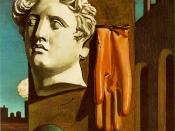As defined by the Collins Concise Dictionary,
Surrealism: a movement in art and literature in the 1920s, which developed especially from Dada, characterized by the evocative juxtaposition of incongruous images in order to include unconscious and dream elements
Surrealism became dominant in Europe between the 1920s and 1930s although greatly diminished after World War II. It grew from the earlier Dada movement which was a Western Europe artistic and literary movement that was based on based on the principles of individualism, visions, states of disorientation, nihilism, chaos and the irrationality of modernity. Like Dadaism, Surrealism emphasized the role of the unconscious to explore the human mind. The surrealism movement was in search of a gateway into society's subconscious, the break down of rational and logical thinking. Surrealism allowed artists to express their dreams and imaginations, away from conscious control and convention, in their artwork.
Surrealism is characterized by an abstract, unfamiliar nature.
Surreal paintings are dreamlike and do not conform to reality because they are meant to be from the subconscious mind. Images of surrealism are commonly contradictory and using unharmonious imagery. Surrealism uses images of hallucination, dreams and imagination to express its irrationality. They provoke thoughts of confusion through abstract ideas, shape, form and juxtaposing seemingly completely random objects, yet at the same time entertaining the viewer. Surrealism is a style which uses fantasy imagery from the subconscious mind and is used with no intention of making the artwork logically understandable.
The surrealist circle was made up of many of the greatest artists of the 20th century, including Jean Arp, Max Ernst, Giorgio de Chirico, Man Ray, Joan Miro, and Rene Magritte. Among them, the most important surrealists were probably Andre Breton and Salvador Dali because they were the founders of the movement.
Andre Breton is usually considered...


